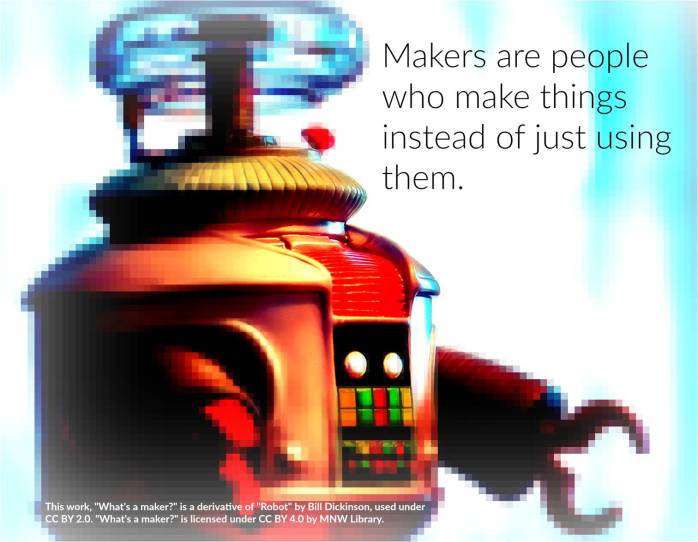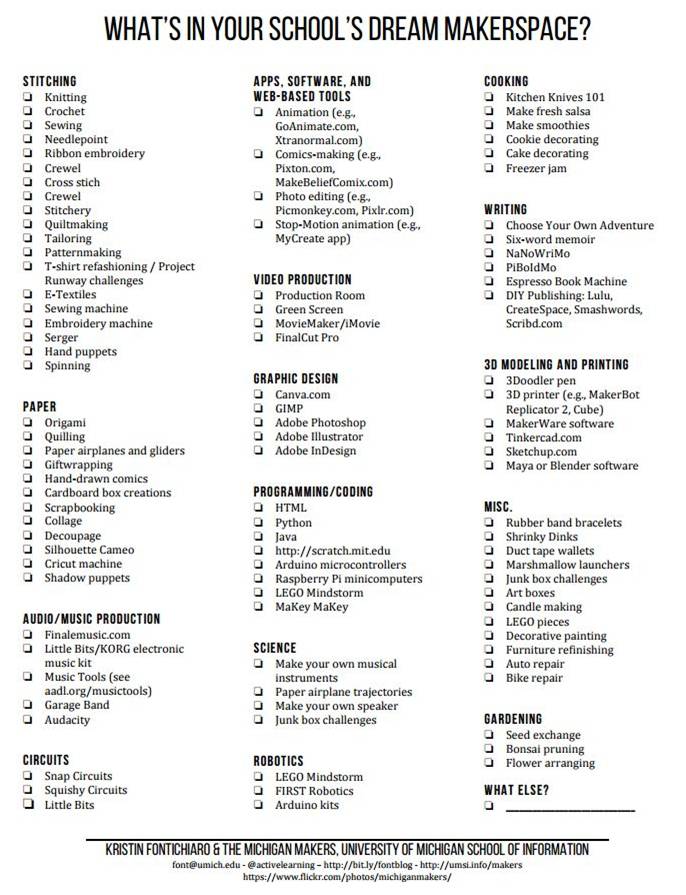From time to time, people ask me about makerspaces. Instead of recreating the wheel each time, I thought I’d write it all here so I can just send them to my blog!

So to me, a makerspace is a community center with tools, the community in this case being the students and staff at the school. I don’t have a soldering iron at my elementary makerspace, but I do in my secondary one. The tools have to be age-appropriate for the audience.
And the tools in a makerspace are varied. I share Kristin Fontichiaro’s list all the time. When I first got started, I gave that list to a few students and asked them what we should get.
And do get student involvement! The maker movement is all about empowering students. Let it be *their* makerspace by letting them have decision-making power. I actually have a Makerspace Club, and we fundraiser and do events and all of that. They make most of the decisions. But just by themselves, makerspaces can help lessen the digital – or resource – divide. I have students who got Lego Mindstorms and Makey Makeys and Wacom tablets and 3D pens for Christmas. Let’s share those sorts of things with the kids who didn’t find those under the tree.
The one thing at the elementary level that I’ve struggled with is getting teachers to see the makerspace as more than just *my* thing. It’s in a space in the library, we have classes most all the day in the library itself so it’s difficult for teachers to use the space or resources in here. This spring and summer, I’m going to work to make it more accessible for teachers and students, so they can check out materials. Barcode numbers and due dates they understand. (I’ve already started some – I have a Makey Makey checked out to a 4th grader and her parents right now. She’s going to meet me next week and tell me all about it.)
But even if I succeed in getting the tools in classrooms, the fact is, not every teacher will use those tools. Elementary teachers are so stinking busy and I honestly feel guilty asking them to put anything more on their plates. So we do “Maker Week” each month, where students come for their regular Library/Technology special class but instead of what we usually do, we do maker activities. Those have varied from coding to fusing plastics, robots to braiding yarn, marble roller coasters (with toilet paper tubes) to stop motion videos to marbling paper (that’s this month’s activity). We hold a maker night a few months of the year and that is for kids and their parents. We don’t get a huge turn out to that but that’s okay. I think the people who come get a lot out of it.

Author photo. All rights reserved.
I think kids sometimes get the message that they aren’t in charge of their learning. It’s all do this and do that, without giving kids ownership of any of it. I think the library can be instrumental in giving them the message that they are in charge of their own learning. We can do that through makerspaces, with the type of existential learning that can occur there. (We can also do that through fighting for our students’ intellectual freedom, but that’s a whole other blog post!)
At the secondary level, makerspaces are a bit easier to set up and for students to use – they have more free time than elementary students – but then it’s on you to do the marketing. Your audience doesn’t come to you in a specials class – you have to go get them. Have an assembly, have making contests, do little workshops on making a craft or treat for a holiday. Keep the makerspace in front of the kids all the time.
OK, so I’ve convinced you. Now what? First, educate yourself on the benefits of a makerspace, and formulate a loose plan. Do you have a room you could put it in? A corner? I did a case study on a high school makerspace that is situated in two different corners of the library. It wasn’t a separate room or anything, just a cart with a bunch of craft supplies accessible to the kids and then a green screen on the wall with a iPad on a tripod. It really doesn’t have to be elaborate, and it’s probably better to start not that way. (That library also has Lego Mindstorms and that sort of thing kept away in the back for kids to check out for library use.) Look around for funding sources – fundraising, material donations, grants. Then go to your administrators and talk to them about makerspaces and tell them what you’ve figured out. Maybe they’ll give you some money to get started.

See the other makerspace posters I made here.
If you’re asked to do a makerspace, make sure you have help. I could not do this without my full-time paras at each building. They’re my eyes and ears on what the kids do every day, what they’re using, what they’re not, what’s giving them fits. I’m not always there.
But remember, you and your paras don’t have to know everything. Think of it this way – librarians are great at facilitation – giving their patrons the books and internet access and meeting space and even cake pans they need (well, North Liberty (IA) Public Library does!). Have we read every book? Well, I haven’t. This is simply one more thing we’re facilitating . . . tools. It doesn’t mean we have to be the resident experts – let our patrons, especially our student patrons – teach us a thing or two. That’s where their real learning begins. (But safety first, of course. See ¶2 above, ” I don’t have a soldering iron at my elementary makerspace.”)
Finally, I think Dale Dougherty, current leader of the maker movement (Seymour Papert has the title of “Father of the Maker Movement) said it best:
Kids today are disengaged and bored in school, and as a result, many see themselves as poor learners. We should be framing things in our schools not just in terms of “how do we test you on that?” but on “what can you do with what you know?” When you’re making something, the object you create is a demonstration of what you’ve learned to do, thus you are providing evidence of your learning.” (Dougherty (2012). The maker movement. Innovations, 7(3), 11-14.)
Sometimes, librarians will talk about makerspace classes and challenges and grades . . . that’s just not how I do things. Makerspaces really should provide existential learning opportunities, giving students a safe place to fail. Dougherty stated, “If schools don’t get the spirit of [the Maker Movement], I don’t think it will benefit them a whole lot” (as cited in Herold, B. (2016). Maker momentum. Education Week, 35(35), 28-30.) But when they do? The sky’s the limit.
(And that shushing thing? You’ll have to give that up. Makerspaces are usually loud and messy. But so is learning.)

Taylor, Laura. ‘Day 174: Amazing Push-Button Shushing Action!” CC BY 2.0
